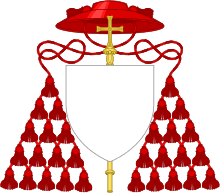Francesco Marmaggi
| Styles of Francesco Marmaggi | |
|---|---|
 | |
| Reference style | His Eminence |
| Spoken style | Your Eminence |
| Informal style | Cardinal |
| See | Hadrianopolis in Haemimonto (titular see) |
Francesco Marmaggi (31 August 1870 – 3 November 1949) was a Cardinal of the Roman Catholic Church who served as Prefect of the Congregation of the Council and, earlier, as Nuncio in Romania, Czechoslovakia and Poland, as well as being a special envoy to Turkey.
Biography
Marmaggi was born in Rome at a time when the Kingdom of Italy was just coming into being. He was educated at the Pontifical Roman Seminary in the city, earning a doctorates in Philosophy and Theology.
Marmaggi was ordained in Rome, on 14 April 1900, and afterwards worked in pastoral care in the Diocese of Rome, as well as being a faculty member of the Pontifical Roman Athenaeum Sant'Apollinare, and an official in the Apostolic Penitentiary until 1904. He was created Privy Chamberlain of Pope Pius X on 15 November 1907, and reappointed on 7 September 1914. Marmaggi was raised to the level of Domestic Prelate on 2 June 1915.
Pope Benedict XV appointed him Titular Archbishop of Hadrianopolis in Haemimonto (Latin for Edirne) and first Nuncio to the Kingdom of Romania on 1 September 1920. The appointment followed a long period of negotiations between Romania and the Papacy, and was replicated by the appointment of Dimitrie Pennescu as first Ambassador of Romania to the Holy See (see Roman Catholicism in Romania).[1] He was consecrated on 26 September by Pietro Gasparri, Cardinal Secretary of State. (Luigi Maglione was consecrated in the same ceremony). Marmaggi represented the Pope at the 1922 coronation of Ferdinand I as King of Greater Romania, a ceremony which took place in Alba Iulia.
Marmaggi was named extraordinary envoy to Turkey after the Greco-Turkish War. This mission was evidence of Pius XI's decision to upgrade the Papacy's diplomatic relations, a policy outlined in the Pacem, Dei Munus Pulcherrimum encyclical, parting with the tradition of French protection for Middle Eastern Catholics.[2] At the time, Pope Pius also sent Celso Constantini to establish contacts with the Beiyang Government in China.[2]
Marmaggi was transferred to be Nuncio to Czechoslovakia in 1923, but, five years later, he was recalled to Rome as a sign of protest. This came as a result of several disagreements between the authorities on both sides, sparked by the Czechoslovak decision to continue celebrating Den upálení mistra Jana Husa, a festival honoring the 15th century thinker Jan Hus, who influenced Protestant dogma and was burned at the stake as a heretic (see Public holidays in the Czech Republic, Roman Catholicism in the Czech Republic).[3][4][5]
Marmaggi left Prague on 6 July 1925, after repeatedly warning President Tomáš Masaryk, Premier Antonín Švehla and Foreign Minister Edvard Beneš not to attend the ceremonies,[4][5] whereas the three officials reputedly argued that they were going to take part in the festival as private persons.[5] Marmaggi's protest was echoed by the Catholic People's Party, who issued criticism of President Masaryk.[4] As a result of his departure, Czechoslovakia cut off diplomatic links with the Papacy.[4]
Marmaggi then served as Nuncio to Poland from 1928, until he was made Cardinal-Priest of Santa Cecilia in the consistory of 16 December 1935 by Pius XI. Two years later, alongside Cardinals Maglione, Pietro Boetto, Nicola Canali, Mario Nasalli Rocca di Corneliano, Alberto di Jorio, Giovanni Mercati, Raffaele Rossi, Carlo Salotti, Federico Tedeschini and Eugène-Gabriel-Gervais-Laurent Tisserant, he sat on a papal commission analyzing the situation created by the Spanish Civil War and the implications the conflict had on the Roman Catholic clergy in Spain.[6] According to historian Vicente Cárcel Ortí, the body was created after Pope Pius was alarmed by Nationalist leader Francisco Franco's decision to overturn Republican reforms (at a time when the zone controlled by Nationalist forces was much smaller than the Republican area).[6]
Cardinal Marmaggi also participated in the conclave of 1939 that elected Pius XII. He left Poland in March 1939, when he was appointed cardinal and Prefect of the Congregation of the Council. Reportedly, he wanted as his successor Angelo Giuseppe Roncalli, the Nuncio to Turkey and Greece and future Pope John XXIII, but his request went unanswered.[7]
Marmaggi was Prefect until his death in 1949. A street in Rome was named in his honor (Via Cardinale Marmaggi).
References
- ↑ (Romanian) Dumitru Preda, Marius Bucur, "România - Vatican. 80 ani de relaţii diplomatice", in Magazin Istoric, May 2000
- ↑ 2.0 2.1 Ernesto Pontieri, Storia universale, Vol.7 (Part 11), Francesco Vallardi, Milan, 1959, p.81
- ↑ "Rendering unto Prague", in Time, February 13, 1928
- ↑ 4.0 4.1 4.2 4.3 Martin Kitchen, Europe Between the Wars, Pearson/Longman, London, 2006, p.207. ISBN 0-582-89414-X
- ↑ 5.0 5.1 5.2 Joseph Rothschild, East Central Europe Between the Two World Wars, University of Washington Press, Seattle, 1992, p.107-108. ISBN 0-295-95357-8
- ↑ 6.0 6.1 Gonzalo Redondo, Historia de la Iglesia en España, 1931-1939, Ediciones Rialp, Madrid, 1993, p.291. ISBN 84-321-3016-8
- ↑ Peter Hebblethwaite, Pope John XXIII, Shepherd of the Modern World, Doubleday, New York, 1985, p.150
| Preceded by Filippo Giustini |
Prefect of the Congregation of the Council 14 March 1939–3 November 1949 |
Succeeded by Domenico Jorio |